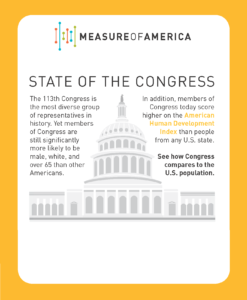State of the Congress 2013
LAUNCHED JANUARY 2013
 The 113th Congress is the most diverse group of representatives in history. Yet its members are still significantly more likely to be male, white, and over 65 than other Americans.[i] And in terms of basic well-being and access to opportunity, members of Congress are far ahead of the average in earnings and education but lag in life expectancy.
The 113th Congress is the most diverse group of representatives in history. Yet its members are still significantly more likely to be male, white, and over 65 than other Americans.[i] And in terms of basic well-being and access to opportunity, members of Congress are far ahead of the average in earnings and education but lag in life expectancy.
How representative are our representatives?
- HUMAN DEVELOPMENT: Members of the 113th Congress score better on the American Human Development Index than people from the top-ranked U.S. state, Connecticut—7.68 out of 10.[ii]
The American Human Development Index is a measure of well-being that combines three central building blocks of a life of choice and value—health, education, and earnings.
- HEALTH: The average American can expect to outlive the average member of the 113th Congress by more than one and a half years.[iii] The disproportionate number of men (the world over, women live longer) and dearth of Asian Americans and Latinos, the racial and ethnic groups that live the longest, pull down the average Congressional life span.
- EDUCATION: Over 95 percent of members of Congress have completed a bachelor’s degree or higher; only 28 percent of the general population has.[iv] While 0.6 percent of the U.S. adult population are lawyers, 41 percent of the 113th Congress are. Members of Congress are sixty-eight times as likely as all American adults to have practiced law.[v]
- EARNINGS: Median annual earnings, the typical wages and salaries of American workers ages 16 and older, are $29,000. Median earnings for members of Congress are $174,000. All Representatives and Senators earn this amount except for the Speaker of the House, President of the Senate, and majority/minority leaders of the House and Senate. These figures include only salaries, not outside income, assets, allowances or benefits.[vi] Put another way, members of Congress earn six times what the typical worker earns annually.
__________________________________________________________________________
For media and all other inquiries,contact us at: contact@measureofamerica.org | (718) 517-3720.
[i] National demographic characteristics are from the U.S. Census Bureau, Vintage 2011 postcensal population estimates. Demographic characteristics of the 113th Congress were derived from official member websites (see directory of House of Representatives’ official websites and directory of Senators’ official websites and the House Press Gallery, 2012 House Election Results website). Totals do not sum to 100 percent for two reasons: 1. rounding; and 2. the population of other groups, such as Native Hawaiians and other Pacific Islanders, are extremely small.
[ii] The American Human Development Index (AHDI) value for the U.S. population is from The Measure of America 2013 (forthcoming). For the 113th Congress, the Index was calculated by Measure of America using the following sources:
LIFE EXPECTANCY: corresponds to the estimate of the gender and racial or ethnic group to which the member belongs for the state the member represents based on Measure of America calculations. Life expectancy for the 113th Congress is the average of the life expectancy estimates for all sitting Members of the 113th Congress.
EDUCATIONAL ENROLLMENT: Assumed to be the same as the value for the nation. For further details, see the Index Methodological Note. Please note however that Measure of America now calculates educational enrollment as the ratio of enrolled students ages 3 to 24 to the total student-age population ages 3 to 24.
EDUCATIONAL ATTAINMENT: Degree attainment of each member. See note iv below for data sources.
EARNINGS: Median Congressional earnings of members of the 113th Congress. See note vi below for data source.
[iii] Measure of America calculations using mortality data from the Centers for Disease Control and Prevention, National Center for Health Statistics and intercensal population estimates from the U.S. Census Bureau in collaboration with the National Center for Health Statistics (NCHS) through the CDC-WONDER on-line database. Estimates are for 2009.
[iv] Educational attainment figures for the U.S. adult population are from the U.S. Census Bureau, American Community Survey 2010. The educational attainment of members of the 113th Congress was compiled from official member websites reference above, from annual New Member Pictorial Directories, from the Washington Times and Washington Post candidate profiles and from the graduation records of colleges and universities attended by sitting members. Honorary degrees were not included.
[v] Licensed lawyers as a percentage of the adult population 25 and older in the U.S. is from the American Bar Association, “Lawyer Demographics 2012.” Licensed lawyers in the 113th Congress was compiled by Measure of America from sources including: official member websites referenced above, the U.S. House of Representatives Office of the Clerk, “Lawyers in the U.S. House of Representatives,” and New Member Pictorial Directories.
[vi] Median personal earnings for the working-age population with earnings are from the U.S. Census Bureau American Community Survey 2010. Median Congressional earnings for the 113th Congress are from Brudnick, I. (2012) “Salaries of Members of Congress: Recent Actions and Historical Tables,” Congressional Research Service.